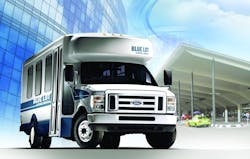Reduce Greenhouse Gas Emissions, Cut Costs with Propane Autogas Vehicles
One way for airports to reduce ground-based greenhouse gas emissions is by transitioning its airport-owned vehicles away from convention fuels to alternative fuels. But, the alternative fuels terrain can be tough to navigate for what works best for airport-based shuttle services. With the various fuel and technology options available in today’s commercial vehicle market, how do you make the right choice for your airport?
Know that airports across the United States are facing this issue head on with airport-wide initiatives that include reducing the carbon footprint of their fleets. For example, the Austin-Bergstrom International Airport’s parking shuttles have been fueled by clean-burning propane autogas since the airport opened. And, private ground transportation providers, such as off-site parking shuttles, are required by contract to use alternative fuels.
Many resources are available to help you research and decide on the best alternative fuel option to power your airport’s fleet. This article will explore emissions-reducing, cost-saving propane autogas.
Propane Autogas Primer
According to the World LP Gas Association, there are more than 27 million on-road vehicles fueled by propane autogas around the world. Propane autogas is the leading alternative fuel in the United States and the third most commonly used vehicle fuel, following gasoline and diesel. In the U.S., there are over 18,000 propane autogas-fueled vehicles on the road.
You don’t need to have a large fleet to garner the benefits — current propane technology enables you to order the number of vehicles you need, whether that’s one or a dozen or 100. This is especially attractive to airports that want to adopt new fuel technology as current aging vehicles are in need of replacement.
There are several funding opportunities available to help pay for these alternative fuel vehicles. The U.S. Energy Department’s Alternative Fuels Data Center lists state and federal funding opportunities, and these vehicles could be eligible for funding from the Volkswagen settlement’s Environmental Mitigation Trust. Depending on your state’s EMT plan to reduce nitrogen oxides (NOx) emissions in accordance with this settlement, funding for Class 4-8 shuttle buses could be included.
Propane autogas vehicles all run on nontoxic, colorless and clean-burning propane autogas, which is an approved alternative fuel under the Clean Air Act. In contrast to nontoxic propane, as little as one gallon of spilled gasoline can quickly contaminate groundwater above drinking water health advisory levels.
Currently, more than 90 percent of U.S. propane supplies come from domestic production, making propane autogas a readily available alternative to imported oil. Propane autogas is an abundant, American-made fuel. Our country produces more than 21 billion gallons of propane and is using only 9 billion gallons for home heating, cooking and transportation. This leaves a surplus for fleets to use this domestic energy source.
Propane autogas vehicles are safe and must meet the same safety standards as gasoline- and diesel-fueled vehicles. To learn more, visit the Propane Education & Research Council’s website at propane.com.
Now that you know more about the fuel itself, here are three steps to convert your fleet vehicles to propane autogas.
Step 1: Understand how propane autogas vehicles can benefit your fleet
Propane autogas, the internationally recognized term used for propane when used in on-road engines, has both economic and environmental benefits.
Compared with conventional fuels, propane autogas costs less per gallon. On average, propane autogas is about 40 percent less than gasoline and 50 percent less than diesel. In addition to fuel savings, fleet operators have experienced lower costs for oil changes and routine maintenance due to the fuel’s clean-burning properties.
Engines powered by propane autogas require less oil per oil change than diesel (7 quarts vs. 17 – 30 quarts), and no additional diesel emissions fluids or hardware. Propane autogas vehicles eliminate the need for particulate trap systems, EGR systems, and turbochargers and intercoolers. Filter packages cost about 60 percent less on propane autogas vehicles than diesel vehicles.
With modern propane autogas systems, the propane remains in a liquid state until it gets to the cylinder. This has alleviated cold start issues associated with vapor technology propane systems of the past. A propane autogas fuel system provides unaided cold weather starts to -40 degrees Fahrenheit, reducing time and labor costs needed on those frigid days.
Propane autogas has the added environmental benefit of reducing emissions. Vehicles fueled by propane autogas emit up to 18 percent fewer greenhouse gases with 20 percent less nitrogen oxide, 60 percent less carbon monoxide, and fewer particulate emissions than models fueled by gasoline.
When compared to conventional diesel, fueling with propane autogas results in an estimated 80 percent reduction in smog-forming hydrocarbon emissions and virtually eliminates particulate matter. Propane autogas is naturally lower in nitrogen oxides (NOx) than diesel and gasoline.
For example, if you replace one gasoline-fueled Ford E-450 chassis with a propane autogas model, more than 91,000 pounds of carbon dioxide will be eliminated over its lifetime. Colonial Airport Parking’s current propane fleet will emit 730,000 fewer pounds of carbon dioxide over its lifetime. Plus, the Philadelphia International Airport-based company has cut fuel costs by 32 percent and bus maintenance costs by 28.4 percent since adopting propane autogas shuttles.
All engines of any fuel type must be certified to the Environmental Protection Agency’s standard. Look for propane engines that go beyond that certification. For instance, one market propane engine is certified to the optional low NOx level 0.05 grams per brake horsepower per hour, making it 75 percent cleaner than the EPA’s current standard.
A savings calculator allows users to input specific information about vehicles owned and miles traveled to calculate potential emissions and cost reductions over the life of the vehicles.
Step 2: Assess what portion of your fleet can be transitioned from conventional fuels to propane autogas
Next, you’ll need to assess your current fleet situation and decide how many vehicles to move from conventional fuels to propane autogas.
A big decision to make is whether to purchase new vehicles or convert existing ones. Either way, you can experience cost savings and emissions reductions of the fuel itself. Although, the greatest return on investment over the life of a vehicle comes when it’s a new vehicle outfitted from the start with a dedicated propane autogas fuel system.
One advantage is that a new propane autogas-fueled vehicle will have the necessary hardened valves and valve seats installed directly from the factory. This valve configuration accommodates propane’s different lubricity (compared to gasoline and diesel), and keeps valves and valve seats from receding. Newly purchased propane autogas vehicles should also come with the original equipment manufacturer warranty intact.
And, propane autogas engines are noticeably quieter. Shuttles and buses fueled by propane autogas reduce noise levels by about half compared to a diesel engine. While diesel engines are commonly associated with producing noticeable engine noise, propane autogas engines allow drivers to better hear and communicate with the passengers onboard.
Comparing total cost of ownership between various vehicles also helps fleet managers make a more informed decision. The higher the annual miles driven and the lower the vehicle’s fuel efficiency, the more likely propane autogas will provide a quick return on investment. How much could your fleet save with propane? This savings calculator from the Propane Education & Research Council will help you measure lifetime operating and ownership costs.
Step 3: Determine a fueling strategy
The last step in making the transition to propane autogas is to determine a fueling strategy. Your choices are to fill up at public propane autogas fueling stations, at a private pump on your fleet’s premises or to contract for onsite fueling services.
Because many company’s vehicles return to a central point at the end of each day, an onsite propane station can easily take care of your fueling needs. Depending on storage necessity, longevity and available space, there are underground storage tanks for longer-term use or aboveground skids that can be replaced or removed. Look for a local fuel supplier to install low or no-cost propane infrastructure. These propane providers specialize in helping fleets choose the right fueling option based on the fleet size, routes, budget and facility space.
According to the Alternative Fuels Data Center, the upfront cost of propane infrastructure is very affordable. In fact, propane autogas fueling infrastructure costs less than any other fueling station — conventional or alternative. Fleet owners may only be responsible for installing permanent equipment like a concrete pad or electricity line for the fuel station. The other costs (that could include paying for a tank, pump and dispensing equipment) may be picked up or offered at low cost to a fleet when it signs a fueling contract with a propane provider.
Because of its Environmental Protection Agency classification as a non-contaminant, propane infrastructure has fewer compliance requirements than conventional fuels, meaning there is no costly EPA monitoring involved.
Another option is to contract with a propane supplier to perform onsite propane autogas fueling services. The propane supplier comes to your location and fuels from their bobtail truck. And for fleets with limited space, public stations can be the solution. There are already thousands of propane stations across the U.S. To find stations near you, visit the Alternative Fuels Data Center.
As part of this step, you should vet both providers of the fuel and the fueling stations. Propane providers can answer your questions about fueling your fleet. You may even already have a propane provider for other equipment, like forklifts or commercial mowers.
With conventional fuel prices on the rise, and the federal government enacting stricter environmental controls, the total ownership cost of diesel vehicles is heading upward. This trend creates a well-timed opportunity to transition vehicles to clean-burning, cost-effective propane autogas and help reduce your airport’s carbon footprint.
Todd Mouw is president of ROUSH CleanTech, an industry leader of alternative fuel vehicle technology. Mouw has served as president of the NTEA Green Truck Association. Reach him at [email protected] or 800.59.ROUSH. To learn more, visit ROUSHcleantech.com.
About the Author

